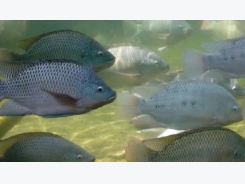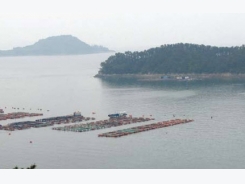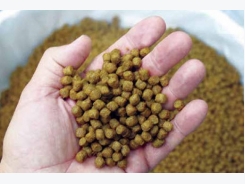Measuring Circulation, Mixing in Ponds

Summary:
Several methods for evaluating water circulation and mixing in aquaculture ponds are available to farm operators. Although effective, measurements of concentrated salt dispersal can be complex. Methods using floats or gypsum blocks to measure current direction and velocity are simpler. Water current meters offer another measuring option

Figure 1. Surface water circulation testing. Blue dye was applied at an aerator in this test pond (a). Most of the pond appeared blue after 20 minutes (b).
Mechanical aerators add dissolved oxygen to water, and depending upon the type, they also effect various de-grees of water circulation. Mechanical water circulators, such as horizontal, axial-flow water circulators, low-speed paddlewheels and propellers, and air-lift pumps are designed to mix and circulate water, but provide limited aeration.
Some pond managers have installed mechanical water circulators to enhance water mixing beyond that provided by aerators. Those who feel that water circula-tion and mixing are equally as important as aeration in ponds seek to position aeration and circulation devices to achieve maximum water circulation.
Visible surface currents provide useful information for positioning this equipment. This technique cannot be quantified, however, and wind action can obscure surface turbulence from water currents. Thus, managers may seek other methods for evaluating water circulation and mixing.
Surface Mixing
My first experience in measuring water circulation in ponds came 30 years ago, when Aeration Industries, Inc. asked me to find a way to make a visual depiction of water currents produced by one of its aerators for use in an advertising brochure. We poured a blue dye in front of the operating aerator while taking interval pictures of the pond surface from a light airplane.
Two graduate students took photos from the tightly circling plane, which had to land at the nearby airport after about 45 minutes. The tight turns had made the stu-dents and pilot quite ill, but they did capture excellent pictures (Figures 1a and 1b).
The dye was completely distributed over the surface of the 0.4-ha pond in about 30 minutes. Of course, this method only revealed surface mixing, and it could not be repeated, for the dye persisted for months.
Overall Mixing
The question then arose: How long would it take an aerator to completely mix the water in a pond of a given size? Several techniques can measure water mixing.
Salt Method
After the dye test, we dissolved 100 kg of sodium chlo-ride in about 400 l of water and quickly poured the salt solution in front of an aerator mounted in a 0.4-ha pond of 1 m average depth. A shift in water salinity of 25 mg/l reflected the mixing effect.
Specific conductance was measured from a boat trav-eling over the pond surface along a grid identified with 12 stakes marked for either surface, mid-depth, or bottom measurements. It took about 10 minutes to complete the measurements for the entire grid. The process was con-tinued until specific conductance measurements were es-sentially uniform within the pond after 70 minutes (Fig-ure 2).
The mixing rate (M.R.) was calculated as follows:

The mixing rate for the 2-hp aerator used in the study was 1,716 m3/hp•hr.

Figure 2. Water conductance after salt distribution in a test pond.
Float Methods
The salt method above can not be used in brackish water and is rather complex for “on-farm” use. One sim-pler method involves tossing floats in front of the aerator and noting their movement. Although wind affects the di-rection taken by light, wooden floats or empty plastic bot-tles, oranges make ideal floats, for they are relatively dense and sink into water enough to prevent wind drift, but not enough to make them difficult to observe.
Oceanographers often use drogues to follow ocean currents. Their current detection depth can be regulated beneath the float, which allows observation of speed and direction. Although these devices can be used in ponds, they tend to become tangled when several are released si-multaneously in front of an aerator.

The rates at which gypsum blocks dissolve can report water circulation.
Gypsum Block Method
Oceanographers also have used the rate of dissolution of small gypsum (plaster of Paris) blocks to measure the relative velocity of water currents in coral reefs. The blocks can easily be made by pouring plaster of Paris into plastic ice cube trays and letting it harden. The indi-vidual blocks can then be cemented with waterproof glue to small sheets of plastic.
In testing, the blocks are weighed and mounted by thumbtacks at prescribed depths on wooden stakes posi-tioned where current measurements are desired. After a few hours or days, depending upon water velocity, the blocks are removed, dried in an oven at 60° C, and reweighed.
The weight loss increases in direct proportion to in-creasing water velocity. By placing gypsum blocks in a pond, it is possible to determine where water currents are fastest and slowest. For best results, it is suggested that one block be suspended in an open submerged container of 100- to 200-l volume. The weight loss from this block can be subtracted from the weight losses of the other blocks to adjust for dissolution in completely still water.
The gypsum block method provides excellent results in ponds with aerators or water circulators. Moreover, the blocks can be attached at different lengths along a horizontal bar attached to a slowly revolving vertical shaft. By calculating the speed at which the blocks at dif-ferent positions travel through the water, the weight loss-es of the blocks convert to water velocity in m/minute.
The gypsum block method provides excellent results in ponds with aerators or water circulators.
Current Meters
Finally, mechanically induced water currents in ponds can be evaluated with the aid of water current me-ters. The meters can be operated from a boat held station-ary at different distances from an aerator. Water cur-rents, and especially the surface current, decrease rapid-ly with distance from aerators (Figure 3). At distances be-yond 80 m, the flow usually is below the detection range of inexpensive current meters.

Figure 3. Water velocity at different distances from a paddlewheel aerator, as measured with an inexpensive, hand-held water current meter.
Related news
Tools

Phối trộn thức ăn chăn nuôi

Pha dung dịch thủy canh

Định mức cho tôm ăn

Phối trộn phân bón NPK

Xác định tỷ lệ tôm sống

Chuyển đổi đơn vị phân bón

Xác định công suất sục khí

Chuyển đổi đơn vị tôm

Tính diện tích nhà kính

Tính thể tích ao




 Feeding Affects Pond Water Quality
Feeding Affects Pond Water Quality  Feed Efficiency Indicators for Responsible Aquaculture
Feed Efficiency Indicators for Responsible Aquaculture